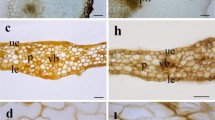Summary
The spikelets of the grass Calamovilfa longifolia (Hook) Scribn. are one flowered and the dispersal unit is composed of a caryopsis (3.5 mm long and 0.9 mm wide) enclosed in lemma and palea. The highest germination of caryopses and emergence of seedlings occurred from 1–2 cm depths and seedling emergence decreased with increasing depth of burial. The maximum depth of sand from which a seedling can emerge is about 8 cm. Seedlings emerging from deep locations had first internodes which were more elongated than those of seedlings from more shallow plantings. Coleoptile lengths of seedlings from shallow or deeply buried caryopses were similar.
Similar content being viewed by others
References
Baldwin KA (1980) Comparative studies of Calamovilfa longifolia in three distinct sand dune habitats. Unpublished data, M.Sc. Research Project, Univ. of Western Ontario, London
Blake A (1935) Viability and germination of seeds and early life history of prairie plants. Ecol Monog 5:405–460
Dawson JH (1963) Development of barnyardgrass seedlings and their response to EPTC. Weed Sci 11:60–67
Dawson JH, Bruns VF (1962) Emergence of barnyardgrass, green foxtail, and yellow foxtail seedlings from various soil depths. Weed Sci 10:136–139
Evans A, Young JA, Roundy BA (1977) Seedbed requirements for germination of sandberg bluegrass. Agron J 69:817–820
Gutterman V, Witztum A, Evanari M (1967) Seed dispersal and germination in Blepharis persica. Israel J Bot 213–234
Harper JL, Obeid M (1967) Influence of seed size and depth of sowing on the establishment and growth of varieties of fiber and oilseed flax. Crop Sci 7:527–532
Harper JL, Benton RA (1966) The behaviour of seeds in soil. The germination of seeds on the surface of a water supplying substrate. J Ecol 54:151–166
Harper JL (1977) Population Biology of Plants. Acad Press, New York, NY
Harty RL, McDonald TJ (1972) Germination behaviour in beach spinifex (Spinifex hirsutus Labill.). Aust J Bot 20:241–251
Kaufmann ML (1968) Coleoptile length and emergence in varieties of barley, oats and wheat. Can J Plant Sci 48:357–361
Maun MA (1981) Seed germination and seedling establishment of Calamovilfa longifolia on Lake Huron sand dunes. Can J Bot (in press)
Meijden van der E, van der Waals-Kooi RE (1979) The population ecology of Senecio jacobaea in a sand dune system. I. Reproductive strategy and the biennial habit. J Ecol 67:131–153
Murphy RP, Arny AC (1939) The emergence of grass and legume seedlings planted at different depths in five soil types. Agron J 31:17–23
Olson JS (1958) Rates of succession and soil changes on southern Lake Michigan sand dunes. Bot Gaz 119:125–170
Payne Anita M (1980) The ecology and population dynamics of Cakile edentula var lacustris on Lake Huron sand dunes. M.Sc. Thesis, Univ. Western Ontario, London, p 193
Ranwell D (1958) Newborough Warren, Anglesey. I. The dune system and dune slack habitat. J Ecol 47:571–601
Salisbury E (1942) The Reproductive Capacity of Plants. G Bell and Sons London
Salisbury E (1952) Downs and Dunes: their plant life and its environment. G Bell and Sons London
Sheldon JC (1974) The behaviour of seeds in soil. III. The influence of seed morphology and behaviour of seedlings on the establishment of plants from surface lying seeds. J Ecol 62:47–66
Simpson M (1952) Value of the awn in establishing seed of Danthonia penicillata. NZ J Sci Tech 34:360–364
Thurston JM (1960) Dormancy in weeds seeds. In: JL Harper (ed), The Biology of Weeds. Blackwell Sci Publications, Oxford pp 69–82
Tothill JC (1969) Soil temperature and seed burial in relation to the performance of Heteropogon contortus and Themeda australis in burnt native woodland pastures in eastern Queensland. Aust J Bot 17:269–275
Van der Valk AG (1974) Environmental factors controlling the distribution of forbs on coastal foredunes in Cape Hatteras National seashore. Can J Bot 52:1057–1073
Wagner RH (1964) The ecology of Uniola paniculata in the dune-strand habitat of North Carolina. Ecol Mono 34:79–96
Watt AS (1919) On the causes of failure of natural regeneration in British oakwoods. J Ecol 7:173–203
Willis AJ, Folkes BF, Hope-Simpson JF, Yemm EW (1959) Braunton Burrows: the dune system and its vegetation. J Ecol 47:1–24
Author information
Authors and Affiliations
Rights and permissions
About this article
Cite this article
Maun, M.A., Riach, S. Morphology of caryopses, seedlings and seedling emergence of the grass Calamovilfa longifolia from various depths in sand. Oecologia 49, 137–142 (1981). https://doi.org/10.1007/BF00376911
Received:
Issue Date:
DOI: https://doi.org/10.1007/BF00376911



